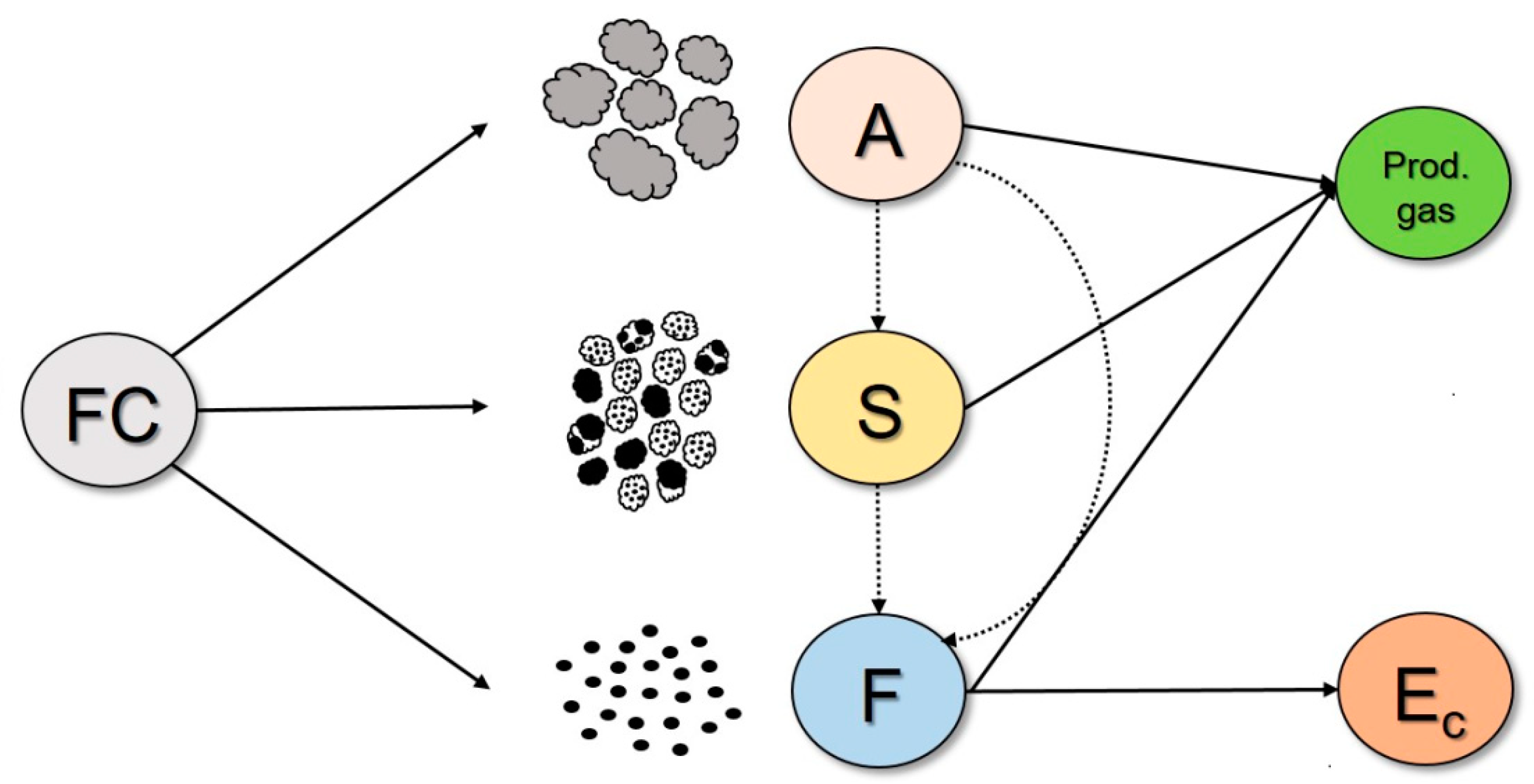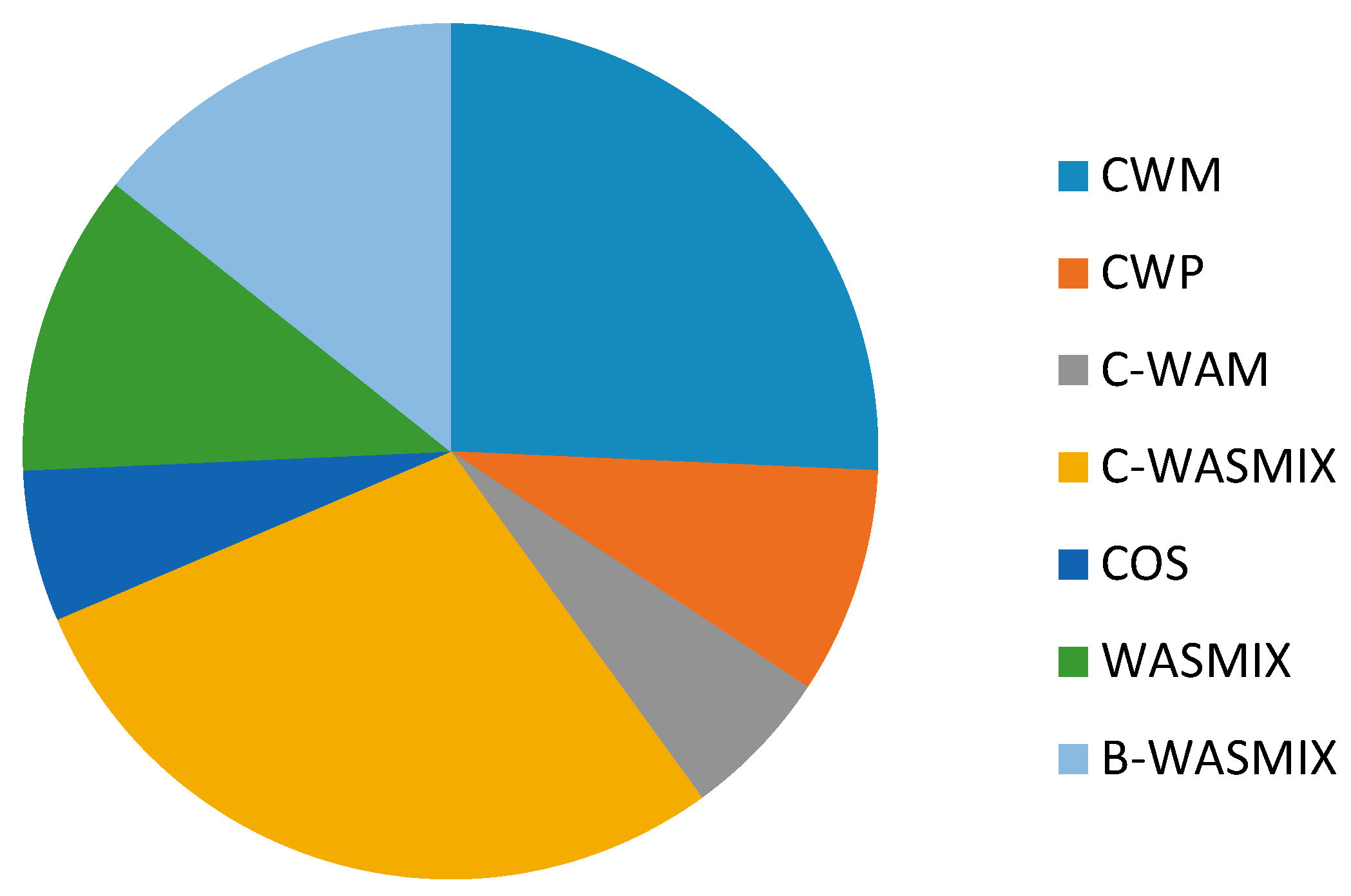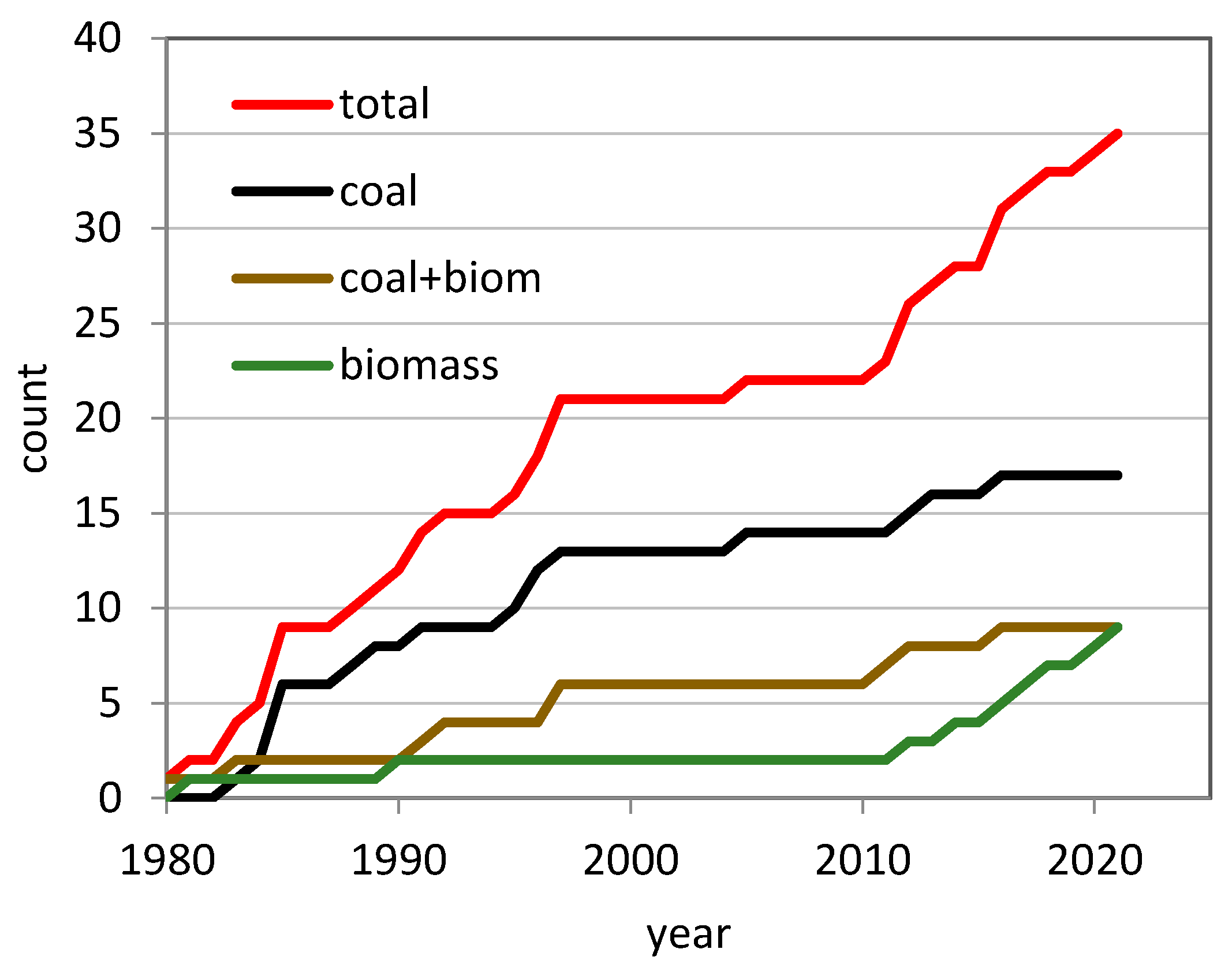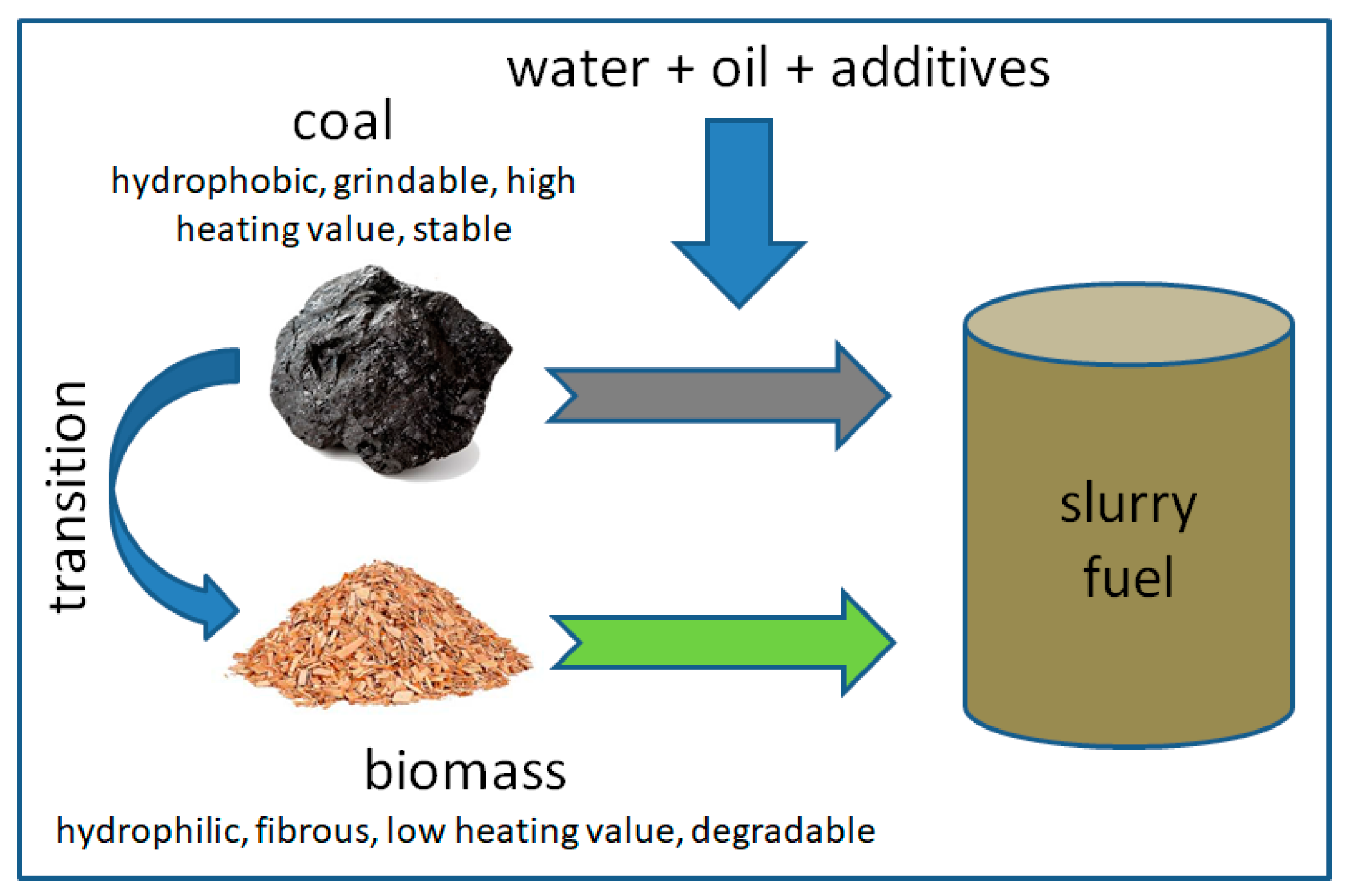Fluidized Bed Combustion and Gasification of Fossil and Renewable Slurry Fuels
Abstract
:1. Introduction
- Coal/coke Water Mixture (CWM)
- Coal Water Paste (CWP)
- Coal–oil Slurry (COS)
- Coal–water Foam (C-WAM)
- Waste Derived Mixture (WASMIX)
2. Coal Water Mixture (CWM)
2.1. Combustion Efficiency
| Internal Size (mm) | Slurry Fuel | Feeding Point | Pressure | Process | Ref. |
|---|---|---|---|---|---|
| 2600 × 1600 2 | CWM | overbed | atmospheric | combustion | [40] |
| 250 1 | CWM | overbed | atmospheric | combustion | [41,42] |
| 600 1 | CWM | submerged | 0.6 MPa | combustion | [37,45] |
| 80 1 250 2 500 2 | CWM | overbed | atmospheric | combustion | [46] |
| 450 1 | CWM | underbed | atmospheric | combustion | [47] |
| 370 1 | CWM | submerged | atmospheric | combustion | [43,44] |
| 300 2 | CWM | submerged | 2 MPa | combustion | [45] |
| 200 1 | CWM | submerged | atmospheric | combustion | [48] |
| 140 1 | CWM | submerged | atmospheric | pyrolysis | [49] |
| 5640 1 | CWP | n.a. | 1.2 MPa | combustion | [50] |
| 51 1 | COS | submerged | atmospheric | combustion | [51] |
| 600 1 | C-WAM | submerged | atmospheric | combustion | [52] |
| 1130 1 | C-WAM | submerged | pressurized | combustion | [52] |
| 140 1 | C-WAM | submerged | atmospheric | pyrolysis | [52] |
2.2. Fuel Dispersion in the Bed
3. Coal–Water Pastes (CWP) and Coal Oils Slurries (COS)
4. Coal–Water Foam (C-WAM)
4.1. Combustion Behavior
4.2. Fuel Dispersion in the Bed
5. Waste-Derived Mixtures (WASMIX)
| Internal Size, mm | Slurry Fuel | Feeding Point | Pressure | Process | Ref. |
|---|---|---|---|---|---|
| 40 1 | WASMIX | submerged | atmospheric | combustion | [59] |
| 20 | WASMIX | submerged | atmospheric | gasification | [61] |
| 600 × 600 2 | WASMIX | submerged | atmospheric | combustion | [25] |
| 1200 × 1200 2 | WASMIX | submerged | atmospheric | combustion | [60] |
| n.a. | C-WASMIX | submerged | atmospheric | combustion | [62] |
| 370 1 | C-WASMIX | submerged | atmospheric | combustion | [63] |
| 3050 × 3050 2 | C-WASMIX | submerged | 1.5 MPa | combustion | [64] |
| 230 × 230 2 | C-WASMIX | submerged | atmospheric | combustion | [65] |
| 110 1 | C-WASMIX | overbed | atmospheric | combustion | [66] |
| 140 1 | C-WASMIX | submerged | atmospheric | gasification | [67] |
| 300 × 300 2 | B-WASMIX | submerged | atmospheric | combustion | [68] |
| 9000 1 | B-WASMIX § | submerged | 2.2 MPa | gasification | [26] |
| 9000 1 | B-WASMIX § | submerged | 4.1 MPa | gasification | [69] |
5.1. Waste Derived Mixtures with Coal Addition (C-WASMIX)
5.2. Waste-Derived Mixture with Biomass Addition (B-WASMIX)
6. Discussion and Perspectives
Author Contributions
Funding
Institutional Review Board Statement
Informed Consent Statement
Data Availability Statement
Conflicts of Interest
References
- Leckner, B. Developments in fluidized bed conversion of solid fuels. Therm. Sci. 2016, 20, S1–S18. [Google Scholar] [CrossRef]
- Blaszczuk, A.; Nowak, W. Bed-to-wall heat transfer coefficient in a supercritical CFB boiler at different bed particle sizes. Int. J. Heat Mass Transf. 2014, 79, 736–749. [Google Scholar] [CrossRef]
- Kunii, D.; Levenspiel, O. Chapter 2—Industrial Applications of Fluidized Beds. In Fluidization Engineering, 2nd ed.; Kunii, D., Levenspiel, O., Eds.; Butterworth-Heinemann: Oxford, UK, 1991; pp. 15–59. [Google Scholar]
- Di Natale, F.; Nigro, R.; Scala, F. 5—Heat and mass transfer in fluidized bed combustion and gasification systems. In Fluidized Bed Technologies for Near-Zero Emission Combustion and Gasification; Scala, F., Ed.; Woodhead Publishing: Sawston, UK, 2013; pp. 177–253. [Google Scholar]
- Basu, P. Combustion and Gasification in Fluidized Beds, 1st ed.; CRC Press: Boca Raton, FL, USA, 2006. [Google Scholar]
- Anthony, E.J. Fluidized bed combustion of alternative solid fuels; status, successes and problems of the technology. Prog. Energy Combust. Sci. 1995, 21, 239–268. [Google Scholar] [CrossRef]
- Trinks, W.; Mawhinney, M.H.; Shannon, R.A.; Reed, R.J.; Garvey, J.R. Industrial Furnaces; John Wiley & Sons, Inc.: Hoboken, NJ, USA, 2004; Chapter 4. [Google Scholar]
- Walas, S.M. Chemical reactors. In Perry’s Chemical Engineers’ Handbook, 7nd ed.; Perry, R.H., Green, D.W., Maloney, J.O., Eds.; McGraw-Hill: New York, NY, USA, 1997. [Google Scholar]
- Massimilla, L.J.; Johnstone, H.F. Reaction kinetics in fluidized beds. Chem. Eng. Sci. 1961, 16, 105–112. [Google Scholar] [CrossRef]
- Anthony, E.J.; Granatstein, D.L. Sulfation phenomena in fluidized bed combustion systems. Prog. Energy Combust. Sci. 2001, 27, 215–236. [Google Scholar] [CrossRef]
- Liu, Y.; Peng, J.; Kansha, Y.; Ishizuka, M.; Tsutsumi, A.; Jia, D.; Bi, X.T.; Lim, C.J.; Sokhansanj, S. Novel fluidized bed dryer for biomass drying. Fuel Process. Technol. 2014, 122, 170–175. [Google Scholar] [CrossRef] [Green Version]
- Iannello, S.; Morrin, S.; Materazzi, M. Fluidised Bed Reactors for the Thermochemical Conversion of Biomass and Waste. KONA Powder Part. J. 2020, 37, 114–131. [Google Scholar] [CrossRef] [Green Version]
- Yang, W.C. Bubbling fluidized beds. In Handbook of Fluidization and Fluid-Particle Systems; Yang, W.C., Ed.; Marcel Deccer Inc.: New York, NY, USA, 2003. [Google Scholar]
- Chirone, R.; Miccio, F.; Scala, F. On the Relevance of Axial and Transversal Fuel Segregation during the FB Combustion of a Biomass. Energy Fuels 2004, 18, 1108–1117. [Google Scholar] [CrossRef]
- Gómez-Barea, A.; Leckner, B. Modeling of biomass gasification in fluidized bed. Prog. Energy Combust. Sci. 2010, 36, 444–509. [Google Scholar] [CrossRef]
- Puig-Arnavat, M.; Bruno, J.C.; Coronas, A. Review and analysis of biomass gasification models. Renew. Sustain. Energy Rev. 2010, 14, 2841–2851. [Google Scholar] [CrossRef]
- Shimizu, T. 15—Pressurized fluidized bed combustion (PFBC). In Fluidized Bed Technologies for Near-Zero Emission Combustion and Gasification; Scala, F., Ed.; Woodhead Publishing: Sawston, UK, 2013; pp. 669–700. [Google Scholar]
- Williams, A. Chapter 7—Combustion of two-phase fuels. In Combustion of Liquid Fuel Sprays; Williams, A., Ed.; Butterworth-Heinemann: Oxford, UK, 1990; pp. 161–185. [Google Scholar]
- McHale, E.T. Coal-water fuel combustion. In Symposium (International) on Combustion; Elsevier: Amsterdam, The Netherlands, 1986; Volume 21, pp. 159–171. [Google Scholar]
- Nunes, L.J.R. Potential of Coal–Water Slurries as an Alternative Fuel Source during the Transition Period for the Decarbonization of Energy Production: A Review. Applied Sciences 2020, 10, 2470. [Google Scholar] [CrossRef] [Green Version]
- Antonini, G.; Francois, O. A new way to handle pulverized coal: The pumpable coal/water/air mixtures (C-WAM). In Proceedings of the 7th International Symposium on Coal Slurry Fuels Preparation and Utilisation, New Orleans, LA, USA, 21–24 May 1985. [Google Scholar]
- Wardell, R.V. Solid preparation and handling. In Pressurized Fluidized Bed Combustion; Cuenca, M.A., Anthony, E.J., Eds.; Springer: Berlin/Heidelberg, Germany, 1995. [Google Scholar]
- Priyadarsan, S.; Annamalai, K.; Sweeten, J.M.; Mukhtar, S.; Holtzapple, M.T. Fixed-bed gasification of feedlot manure and poultry litter biomass. Trans. ASAE 2004, 47, 1689–1696. [Google Scholar] [CrossRef]
- Qian, X.; Lee, S.; Chandrasekaran, R.; Yang, Y.; Caballes, M.; Alamu, O.; Chen, G. Electricity Evaluation and Emission Characteristics of Poultry Litter Co-Combustion Process. Appl. Sci. 2019, 9, 4116. [Google Scholar] [CrossRef] [Green Version]
- Miccio, F.; Ruoppolo, G.; Russo, S.; Urciuolo, M.; De Riccardis, A. Fluidized bed combustion of wet biomass fuel (olive husks). Chem. Eng. Trans. 2014, 37, 1–6. [Google Scholar]
- De Souza-Santos, M.L. Proposals for power generation based on processes consuming biomass-glycerol slurries. Energy 2017, 120, 959–974. [Google Scholar] [CrossRef]
- Okasha, F.M.; El-Emam, S.H.; Mostafa, H.K. The fluidized bed combustion of a heavy liquid fuel. Exp. Thermal Fluid Sci. 2003, 27, 473–480. [Google Scholar] [CrossRef]
- Okasha, F. Smooth combustion of gaseous fuels in a novel configuration of fluidized bed. Fuel 2013, 106, 512–518. [Google Scholar] [CrossRef]
- Wang, F.; Yu, G.; Liu, H.; Li, W.; Guo, Q.; Xu, J.; Gong, Y.; Zhao, H.; Lu, H.; Shen, Z. Opposed multi-burner gasification technology: Recent process of fundamental research and industrial application. Chin. J. Chem. Eng. 2021, 35, 124–142. [Google Scholar] [CrossRef]
- Mielke, K.; Kolb, T.; Müller, M. Chemical fractionation of inorganic constituents in entrained flow gasification of slurry from straw pyrolysis. Biomass Bioenergy 2020, 141, 105732. [Google Scholar] [CrossRef]
- Ayol, A.; Tezer Yurdakos, O.; Gurgen, A. Investigation of municipal sludge gasification potential: Gasification characteristics of dried sludge in a pilot-scale downdraft fixed bed gasifier. Int. J. Hydrog. Energy 2019, 44, 17397–17410. [Google Scholar] [CrossRef]
- Freda, C.; Cornacchia, G.; Romanelli, A.; Valerio, V.; Grieco, M. Sewage sludge gasification in a bench scale rotary kiln. Fuel 2018, 212, 88–94. [Google Scholar] [CrossRef]
- Hupa, M. Ash-Related Issues in Fluidized-Bed Combustion of Biomasses: Recent Research Highlights. Energy Fuels 2012, 26, 4–14. [Google Scholar] [CrossRef]
- Miccio, F.; Murri, A.N.; Medri, V.; Landi, E. Utilization of Fireclay for Preventing Fluidized-Bed Agglomeration during Biomass Thermochemical Processing. Ind. Eng. Chem. Res. 2019, 58, 23498–23507. [Google Scholar] [CrossRef]
- Vodička, M.; Michaliková, K.; Hrdlička, J.; Hofbauer, C.; Winter, F.; Skopec, P.; Jeníková, J. External bed materials for the oxy-fuel combustion of biomass in a bubbling fluidized bed. J. Cleaner Prod. 2021, 321, 128882. [Google Scholar] [CrossRef]
- Chirone, R.; Massimilla, L.; Salatino, P. Comminution of carbons in fluidized bed combustion. Prog. Energy Combust. Sci. 1991, 17, 297–326. [Google Scholar] [CrossRef]
- Roberts, A.G.; Pillai, K.K.; Barker, S.N.; Carpenter, L.K. Combustion of ‘Run-of-Mine’ Coal and Coal-Water Mixtures in a Small PFBC. In Proceedings of the International Conference on Fluidized Bed Combustion, Philadelphia, PA, USA, 25–27 October 1982; pp. 482–489. [Google Scholar]
- Bonfitto, E.; Jacoboni, S.; Rossi, C.; Grazzini, G.C.; Frandi, R.; Marchini, G.; Brunetti, N. Combustion Technologies for a Clean Environment; Vilamoura, P., Carvalho, M.G., Eds.; CRC Press: Boca Raton, FL, USA, 1991; Volume 1, pp. 18–27. [Google Scholar]
- Miccio, M.; Miccio, F. 8—Conversion of liquid and gaseous fuels in fluidized bed combustion and gasification. In Fluidized Bed Technologies for Near-Zero Emission Combustion and Gasification; Scala, F., Ed.; Woodhead Publishing: Sawston, UK, 2013; pp. 388–434. [Google Scholar]
- La Nauze, R.D.; Duffy, G.J.; Potter, E.C.; Bradshaw, A.V. Fluidized Combustion of Coal Washery Wastes. In Fluidization; Grace, J.R., Ed.; Springer: Boston, MA, USA, 1980. [Google Scholar]
- Trivett, G.S.; Field, R.S.; Mackay, G.D. Coal-limestone-water slurry testing in atmospheric fluidized-bed combustion. In Proceedings of the 6th International Symposium on Coal Slurry, Combustion and Technology, Orlando, FL, USA, 25 June 1984. [Google Scholar]
- Trivett, G.S.; Field, R.S.; MacKay, G.D. C-coal-limestone-water slurry testing in atmospheric fluidized-bed combustion. In Proceedings of the Eighth International Conference on Fluidized-Bed Combustion, Houston, TX, USA, 18–21 March 1985; Volume 2, pp. 948–961. [Google Scholar]
- Arena, U.; De Michele, G.; Maresca, A.; Massimilla, L.; Miccio, M. Fluidized combustion of coal and coal-water slurry: A comparison. In Proceedings of the Eighth International Conference on Fluidized-Bed Combustion, Houston, TX, USA, 18–21 March 1985; Volume 2, pp. 895–902. [Google Scholar]
- Massimilla, L.; Miccio, M. The mechanism of combustion of a coal-water-slurry in a fluidized bed. Symp. Int. Combust. 1988, 21, 357–367. [Google Scholar] [CrossRef]
- Hoy, R.; Scott, R.L.; Roberts, A.G. Operation of a small combustor on dry coal and on coal-water mixtures at pressures up to 20 atm. In Proceedings of the Eighth International Conference on Fluidized-Bed Combustion, Houston, TX, USA, 18–21 March 1985; pp. 291–306. [Google Scholar]
- Kefa, C.; Minghu, X.; Mingjiiang, N.; Xinyu, C.; Zhenfu, Y.; Guang, H.; Chongoing, L.; Deshou, L.; Yunsien, C. Fifth International Symposium on Coal Slurry Combustion, 1983; Volume 2, pp. 1092–1107. Available online: http://cn.shizueadachi.xyz/read/?id=-SJZAAAAYAAJ&format=pdf&server=1 (accessed on 10 November 2021).
- Mei, J.S.; Cho, J.C.; Martin, D. In Proceedings of the 6th International Meeting on Coal-Liquid and Alternative Fuels, Halifax, NS, Canada, 13–17 October 1986. Available online: https://digital.library.unt.edu/ark:/67531/metadc710580/m2/1/high_res_d/677061.pdf (accessed on 10 November 2021).
- Gregory, J.W.; Brown, R.C. Mechanisms of coal-water mixture combustion in fluidized beds. In Proceedings of the 10th International Conference on Fluidized Bed Combustion: FBC, Manaker, San Francisco, CA, USA, 30 April–3 May 1989. [Google Scholar]
- Miccio, F.; Miccio, M.; Okasha, F. Formation rates of characteristic carbon phases during fuel-water slurry injection in a hot fluidized bed. Powder Technol. 1997, 91, 237–251. [Google Scholar] [CrossRef]
- Anderson, J.; Jansson, S.A. Commissioning experience from three PFBC plants. In Proceedings of the International Conference on Fluidized Bed Combustion, Montreal, QC, Canada, 21–24 April 1991; pp. 787–793. [Google Scholar]
- Svoboda, K.; Pohořelý, M.; Jeremiáš, M.; Kameníková, P.; Hartman, M.; Skoblja, S.; Šyc, M. Fluidized bed gasification of coal–oil and coal–water–oil slurries by oxygen–steam and oxygen–CO2 mixtures. Fuel Process. Technol. 2012, 95, 16–26. [Google Scholar] [CrossRef]
- Antonini, G.; Gaporaud, M.B.; Brunello, J.M.; Grazzini, G.; Tonfoni, C.; Miccio, F.; Miccio, M. Efficiency of Combustion of a Specially Formulated Coal-Water Froth. In Proceedings of the 13th International Conference on Fluidized-Bed Combustion, Orlando, FL, USA, 7–10 May 1995; Volume 1, pp. 125–137. [Google Scholar]
- Okasha, F.; Miccio, M. Prediction of coal-water slurry dispersion in a fluidized bed combustor. Symp. Combust. 1996, 26, 3277–3285. [Google Scholar] [CrossRef]
- Massimilla, L. Gas jets in fluidized beds. In Fluidization, 2nd ed.; Davidson, J.F.C., Harrison, D., Eds.; Academic Press: London, UK, 1985; pp. 133–172. [Google Scholar]
- Lu, P.; Zhang, M. Rheology of coal–water paste. Powder Technol. 2005, 150, 189–195. [Google Scholar] [CrossRef]
- Jansson, S.A.; Veenhuizen, D.; Pillai, K.K.; Bjorklund, J. Coal-Fired PFBC Machine: Operating Experience and Further Development; American Society of Mechanical Engineers (Paper): New York, NY, USA, 1996; pp. 1–5. [Google Scholar]
- Glushkov, D.O.; Lyrshchikov, S.Y.; Shevyrev, S.A.; Strizhak, P.A. Burning Properties of Slurry Based on Coal and Oil Processing Waste. Energy Fuels 2016, 30, 3441–3450. [Google Scholar] [CrossRef]
- Pinto, F.; André, R.N.; Lopes, H.; Franco, C.; Carolino, C.; Galhetas, M.; Miranda, M.; Gulyurtlu, I. Comparison of a pilot scale gasification installation performance when air or oxygen is used as gasification medium 2—Sulphur and nitrogen compounds abatement. Fuel 2012, 97, 770–782. [Google Scholar] [CrossRef]
- Cammarota, A.; D’Amore, M.; Donsì, G.; Massimilla, L. Fluidized bed incineration of a slurry waste from caprolactam production. Symp. Combust. 1981, 18, 257–264. [Google Scholar] [CrossRef]
- Kerr, K.; Probert, S.D. Fluidised-bed incineration of acid tar wastes. Appl. Energy 1990, 35, 189–243. [Google Scholar] [CrossRef]
- Sricharoenchaikul, V.; Atong, D. Fluidized Bed Gasification of Glycerol Waste for Generation of Fuel Products. J. Biobased Mater. Bioenergy 2012, 6, 643–649. [Google Scholar] [CrossRef]
- Mariani, G.; Benfenati, E.; Fanelli, R.; Nicoli, A.; Bonfitto, E.; Jacopone, S. Incineration of agro-industrial wastes and macro- and micropollutants emission. Chemosphere 1992, 24, 1545–1551. [Google Scholar] [CrossRef]
- Miccio, F.; Miccio, M. Dispersion and co-combustion studies for disposal of agro-industrial effluents in bubbling fluidized bed. In Proceedings of the 14th International Conference on Fluidized Bed Combustion, Vancouver, BC, Canada, 11–14 May 1997; pp. 1255–1266. [Google Scholar]
- North, B.C.; Eleftheriades, C.M. Incineration of a biomass sludge in a bubbling FBC. In Proceedings of the 14th International Conference on Fluidized Bed Combustion, Vancouver, BC, Canada, 11–14 May 1997. [Google Scholar]
- Zhao, X.L.; Zhu, W. Emission Characteristicsof of PCBs of Combustion of Sludge-Coal Water Slurry in Fluidized Bed. Appl. Mech. Mater. 2013, 340, 382–387. [Google Scholar] [CrossRef]
- Chen, D.; Yang, Q.; Jiang, X.; Lv, G.; Ma, Z.; Yan, J.; Cen, K.; Yu, X.; Liao, H.; Zhao, H. Comparison of Combustion and Emission Characteristics of an Indonesian Lignite Washery Tailing Slurry with a Bituminous Coal in a Bench-Scale Bubbling/Circulating Fluidized Bed Combustor. Energy Fuels 2016, 30, 10835–10846. [Google Scholar] [CrossRef]
- Ruoppolo, G.; Cante, A.; Chirone, R.; Miccio, F.; Stanzione, V. Fluidized bed gasification of coal/biomass slurries. Chem. Eng. Trans. 2011, 24, 13–18. [Google Scholar]
- Miccio, F.; Solimene, R.; Urciuolo, M.; Brachi, P.; Miccio, M. Fluidized bed combustion of a lignin-based slurry. Chem. Eng. Trans. 2016, 50, 271–276. [Google Scholar]
- de Souza-Santos, M.L.; Camara, M.A. Theoretical Study on the Effect of Glycerol Fraction in Slurries with Biomass Consumed by a Power-Generation Process. Energy Fuels 2018, 32, 497–509. [Google Scholar] [CrossRef]
- Ruoppolo, G.; Chirone, R.; Miccio, F.; Miccio, M.; Silvestri, N. On the mechanism of coal-biomass slurry fluidized bed gasification. In Proceedings of the 21st International FBC Conference, Napoli, Italy, 3–6 June 2012; pp. 789–796. [Google Scholar]
- Miccio, F.; Scala, F.; Chirone, R. Fluidized Bed Combustion of a Biomass Fuel: Comparison between Pilot Scale Experiments and Model Simulations. J. Heat Transfer. 2005, 127, 117–122. [Google Scholar] [CrossRef]
- Cadavez, C.C.; de Souza-Santos, M.L. Efficiency of a power generation alternative regarding the composition of feeding biomass-glycerol slurry; theoretical assessment. Energy 2021, 214, 118967. [Google Scholar] [CrossRef]
- Davidson, J.F. Circulating fluidised bed hydrodynamics. Powder Technol. 2000, 113, 249–260. [Google Scholar] [CrossRef]
- Grace, J.R.; Lim, C.J. 4—Properties of circulating fluidized beds (CFB) relevant to combustion and gasification systems. In Fluidized Bed Technologies for Near-Zero Emission Combustion and Gasification; Scala, F., Ed.; Woodhead Publishing: Sawston, UK, 2013; pp. 147–176. [Google Scholar]
- Hosoda, S.; Kashima, N.; Sekikawa, S.; Toyoda, S.; Aoki, K.; Miyoshi, N. Status of pressurized internally circulating fluidized-bed gasifier (PICFG) development project. In Proceedings of the 15th International Conference on Fluidized Bed Combustion, Savannah, GA, USA, 16–19 May 1999. [Google Scholar]
- Okasha, F.M. Short overview on the jetting-fountain fluidized bed (JFFB) combustor. Renew. Sustain. Energy Rev. 2016, 55, 674–686. [Google Scholar] [CrossRef]
- Jones, J.M.; Saddawi, A.; Dooley, B.; Mitchell, E.J.S.; Werner, J.; Waldron, D.J.; Weatherstone, S.; Williams, A. Low temperature ignition of biomass. Fuel Process. Technol. 2015, 134, 372–377. [Google Scholar] [CrossRef] [Green Version]
- Żukowski, W.; Jankowski, D.; Baron, J.; Wrona, J. Combustion dynamics of polymer wastes in a bubbling fluidized bed. J. Clean. Prod. 2021, 320, 128807. [Google Scholar] [CrossRef]
- Niklasson, F.; Thunman, H.; Johnsson, F.; Leckner, B. Estimation of Solids Mixing in a Fluidized-Bed Combustor. Ind. Eng. Chem. Res. 2002, 41, 4663–4673. [Google Scholar] [CrossRef]
- Yates, J.G.; MacGillivray, M.; Cheesman, D.J. Coal devolatilisation in fluidised bed combustors. Chem. Eng. Sci. 1980, 35, 2360–2361. [Google Scholar] [CrossRef]
- Nyashina, G.S.; Kuznetsov, G.V.; Strizhak, P.A. Effects of plant additives on the concentration of sulfur and nitrogen oxides in the combustion products of coal-water slurries containing petrochemicals. Environ. Pollut. 2020, 258, 113682. [Google Scholar] [CrossRef]
- Pröll, T.; Aichernig, C.; Rauch, R.; Hofbauer, H. Fluidized bed steam gasification of solid biomass—Performance characteristics of an 8 MWth combined heat and power plant. Int. J. Chem. Reactor Eng. 2007, 5, A54. [Google Scholar] [CrossRef]




| Components (% wt.) | German Coal–Oil Slurry (50/50) | Polish Coal–Oil Slurry (50/50) | Polish Coal–Oil–Water Slurry (47/40/12) |
|---|---|---|---|
| Water | 4.50 | 3.85 | 43.37 |
| Ash | 1.90 | 4.33 | 4.07 |
| Volatiles | 71.7 | 61.7 | 33.9 |
| Fixed carbon | 21.8 | 30.1 | 18.6 |
| C (dry) | 70.94 | 75.98 | 73.42 |
| H (dry) | 8.18 | 7.88 | 5.76 |
| O (dry) | 18.46 | 10.86 | 12.42 |
| N (dry) | 0.347 | 0.552 | 0.880 |
| S (dry) | 0.084 | 0.220 | 0.326 |
| Cl (dry) | <0.1 | <0.4 | <0.4 |
| LHV, MJ/kg | 29.8 | 32.3 | 16.8 |
Publisher’s Note: MDPI stays neutral with regard to jurisdictional claims in published maps and institutional affiliations. |
© 2021 by the authors. Licensee MDPI, Basel, Switzerland. This article is an open access article distributed under the terms and conditions of the Creative Commons Attribution (CC BY) license (https://creativecommons.org/licenses/by/4.0/).
Share and Cite
Miccio, F.; Raganati, F.; Ammendola, P.; Okasha, F.; Miccio, M. Fluidized Bed Combustion and Gasification of Fossil and Renewable Slurry Fuels. Energies 2021, 14, 7766. https://doi.org/10.3390/en14227766
Miccio F, Raganati F, Ammendola P, Okasha F, Miccio M. Fluidized Bed Combustion and Gasification of Fossil and Renewable Slurry Fuels. Energies. 2021; 14(22):7766. https://doi.org/10.3390/en14227766
Chicago/Turabian StyleMiccio, Francesco, Federica Raganati, Paola Ammendola, Farouk Okasha, and Michele Miccio. 2021. "Fluidized Bed Combustion and Gasification of Fossil and Renewable Slurry Fuels" Energies 14, no. 22: 7766. https://doi.org/10.3390/en14227766






